
https://must-see.top/dostoprimechatelnosti-severnoj-osetii-alanii/
https://аланиянацмузей.рф/
https://caucasus-explorer.com/tur-v-osetiyu-ingushetiyu/
North Ossetian villages offer curious pagan rituals involving pies and
sacred beer. Worthwhile destinations include the striking rock fortress of
Dzivgis, medieval settlements in the Mamison valley, and a 'city of the dead'
amid dramatic mountain scenery near the village of Dargavs.
Vladikavkaz
How do I arrive to North Ossetia-Alania?
- Plane:
there's an airport, Beslan Airport (15 km far from Vladikavkaz, that
has flights to some of the most important cities in Russia such as
Rostov-on-Don, Moscow or St. Petersburg.
- Train:
there are trains that link Vladikavkaz Railway Station with
Rostov-on-Don (aprox. 13 hours), Sochi (daily; aprox. 17 hours), Moscow (daily; aprox.
1 day 9 hours) or St. Petersburg (daily; aprox. 2 days). Other
destinations within Russia are Adler (aprox. 17 hours) or Novorossiysk
(aprox. 18 hours) in Krasnodar Krai.
- Bus: most of the cities in North Caucasus are connected with Vladikavkaz such as Nazran (Ingushetia), Nalchik (Kabardino-Balkaria), Pyatigorsk and Stavropol (Stavropol Krai), Krasnodar (Krasnodar Krai) or Volgograd (Volgograd Oblast). From here it's also possible to reach Tbilisi (Georgia) or places in Armenia too. Vladikavkaz is the only way to enter into the de facto Republic of South Ossetia, arriving to Tskhinvali.
- Car: if you have a car from Vladikavkaz it can be reached places in North Ossetia-Alania like Beslan (aprox. 35 minutes), Alagir (aprox. 40 minutes), Mozdok (aprox. 1 hour 30 minutes) or Alaniya National Park (aprox. 2 hours 20 minutes). It can also be reached from other places in Russia such as Nazran (aprox. 40 minutes) in Ingushetia; Grozny (aprox. 1 hour 40 minutes) in Chechnya; Nalchik (aprox. 1 hour 50 minutes) in Kabardino-Balkaria; Pyatigorsk (aprox. 2 hours 50 minutes), Mineralnye Vody (aprox. 3 hours) or Stavropol (aprox. 5 hours 10 minutes) in Stavropol Krai; or Krasnodar (aprox. 8 hours 15 minutes) in Krasnodar Krai. Vladikavkaz can also be reached from cities in Georgia like Stepantsminda (aprox. 1 hour), Mtskheta (aprox. 4 hours 10 minutes), Tbilisi (aprox. 4.5 hours) or Gori (aprox. 4 hours 50 minutes).
History
 |
| Territories controlled by Alans in the Iberian Peninsula |
 |
| Comparison of medieval Alania with present Ossetia-Alania |
 |
| Nicephorus III and Maria of Alania |
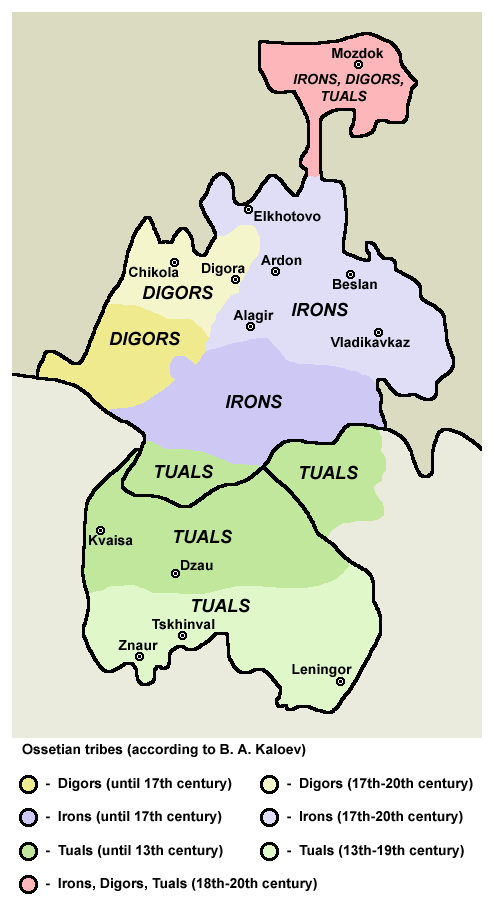 |
| Ossetian tribes |
 |
| Ossetians in Russo-Turkish War |
North Ossetia became part of the short-lived Soviet Mountain Republic in 1921 after the Russian Revolution.
 |
| Districts of the Mountain ASSR in 1921 |
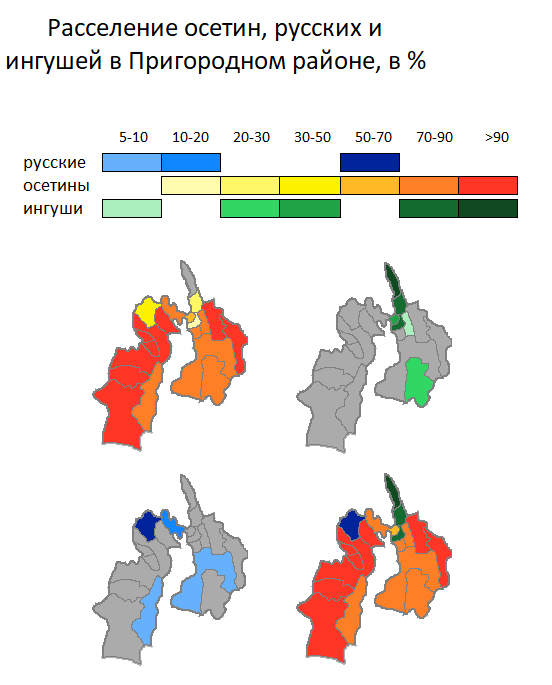 |
| Ethnic distribution of Russians, Ossetians and Ingush in Prigorodny |
What can I visit in North Ossetia-Alania?
- Vladikavkaz (Дзæуджыхъæу in Ossetian, Владикавказ in Russian): is
a 306,258
inhabitants city at the foothills of Caucasus Mountains, by Terek River, being the capital the Republic of North Ossetia-Alania. It is one of the most important cities in the north of the Caucasus.
- Novy Afon (Афон Ҿыц in Abkhaz, ახალი ათონი in Georgian, Новый Афон in Russian): 1,518 inhabitants town by the Black Sea, located 22 km far from Sukhumi.
Its name means New Athos because monks from Rossikon Monastery on Mount
Athos arrived here for place for possible resettlement during
Russo-Turkish War. The town is famous for having a popular and
facilitated cave.
-
New Athos Monastery: Neo-Byzantine
monastery established in the 1880s by Russian monks which came from Mt.
Athos (Greece) with funds provided by Tsar Alexander III of Russia.
During Soviet times it was used for other purposes, such as a tourist base or a hospital, but when it collapsed, the monastery was recovered as a temple. Inside the complex Neo-Byzantine style frescoes can be seen (very well preserved)
Interior of New Athos Monastery - Stalin's Summer House: manor that is one of the 5 dachas (a seasonal
or year-round second home typical of Russian-speaking countries), that
Joseph Stalin had. It had its own railway station too.
- Novy Afon Beach: nice local stone beach from where enjoying beautiful sunsets. Next it there's the Novy Afon Seaside Park, a park with system of ponds fed by river Psyrtsha.
- Parchinskaya Tower:
tower from Genoese origin that is the only surviving tof the coastline
fortifications of the ancient capital Anakopia, a trading and port
citythat existed from the 4th to the 17th century.
- St. Simon the Canaanite Abkhaz Orthodox Church:
church, influenced by the Byzantine and Georgian art traditions, that dates back from the 9th-10th century and is dedicated to St. Simon the Canaanite (who is said to have preached Christianity in Abkhazia and Egrisi according to the 11th-century Georgian Chronicles). The church was abandoned but still standing (except for the collapsed dome) until in the 1880s, the church was reconstructed. The church is adorned with images of Christian symbols such as a fish, lion, and cross curved in relief..jpg/1280px-2014_Nowy_Aton%2C_Cerkiew_%C5%9Bw._Szymona_Aposto%C5%82a_(06).jpg)
St. Simon the Canaanite
Abkhaz Orthodox Church - Museum of the Kingdom of Abkhazia (10-18; 100₽):
museum that shows the history of the Abkhazia going back to the times of deep antiquity (the first Abkhaz kings date back to the 1st-2nd centuries, supported by Roman authorites). The exhibition consists on paleontological, archaeological and ethnographic objects (some found on Anacopia Fortress) and materials showing the history of the Abkhaz statehood and historical reconstructions of military and hunting equipment.
Exhibition at the Museum
of the Kingdom of Abkhazia - Novy Afon Waterfall: waterfull produced by a small hydroelectric power station and artificial lake on the river Psyrtskha river,
built by the monks of the monastery between 1892 and 1903 and repaired in 1922. It produces an estimated 100 kW per hour for the monastery. Next to it there's the picturesque Psirtskha Railway Station, from Soviet times.Artificial lake and Psirtskha Station - Novy Afon Cave (9-18 Wed-Thu, 9-18 Sat-Sun; 500₽/ 100₽/ free adults/ reduced/ kids under 8): karst cave in the Iverian Mountain, few km far from Novy Afon, that consists on 9 major cavities with numerous stalactites and stalagmites in many bizarre shapes.
The complex of caves is the most touristic one in Abkhazia and largest caves in the world (it has a volume of about 1,000,000 m³), it's not even in its top 10 of Abkhaz caves in terms of length. To get into the caves the visitor has to take New Athos Cave Railway, also known as New Athos Subway, an underground electric railroad that transports visitors to the otherwise difficult-to-access cave. In case of wanting to take pictures it costs 50₽..jpg/1280px-New_Athos_cave_(3338661608).jpg)
Novy Afon Cave - Anacopia Fortress (7-21; 200₽): ruins of the 8th century fortress of Anakopia, capital of Abkhazia in those years (first a
princedom in the orbit
of the Byzantine Empire and then, archon Leon II declared himself a king in the late 8th century), till it was move to Kutaisi. It was first an ancient Greek port town and in the 5th century Georgians built a fortress here. Anacopia was ceded to Byzantine Empire (1033) but was retaken by Georgians in 1072 when the Empire was defeated at the battle of Manzikert. Some of its most important sights are the eastern tower of the citadel, and the Temple of Theodor Tiron, a 11th century church that was first built in 6th-7th centuries where it was located the miracolous Iberian Icon of Mother of God (now it's just kept, the original is kept in the Iberian monastery on Mount Athos, Greece..jpg/1280px-2014_Nowy_Aton%2C_Twierdza_Anakopia_(01).jpg)
Anacopia Fortress 
Gudauta
-
New Athos Monastery: Neo-Byzantine
monastery established in the 1880s by Russian monks which came from Mt.
Athos (Greece) with funds provided by Tsar Alexander III of Russia.
- Gudauta (Гәдоуҭа in Abkhaz, გუდაუთა in Georgian, Гудаута in Russian): 8,514 people town on the Black Sea, 37 km northwest to Sukhumi.
It used to be home to a Soviet Air Defence Forces base (Bombora
airfield) and it was a center of Abkhaz resistance to Georgian
government forces during the Georgian-Abkhaz conflict (1992–1993)
because, according to Georgia, it offered military support to Abkhaz
rebels. In 1995, Georgia legitimized Russian leases of three bases
(Gudauta base among them). After the Russo-Georgian War, Russia
recognized Abkhazia as independent and signed with its government the
treaty allowing Russia to keep its military base in Gudauta and
reinforce it.

Exhibitions at Abazgia Museum - The town has several monuments to war heroes of Abkhazia such as Dbar Sergei Platonovich orWolf Vitaly Alexandroviu and the Abkhazian-Georgian War Memorial.
- Abazgia Museum
(9-12 and 13-18 Mon-Thu, 9-17 Sun; free): museum of local history that
contains household items, handicrafts and works of art of modern
Abkhazia.
It consists on four exhibitions halls: two of them dedicated to the
Georgian-Abkhaz conflict, one to archeology and another to ethnography.It's focused in the area of Abazgia, the region of Abkhazia between the rivers Zhayuapsy (near Gagra) and Psyrtskha (near Novy Afon).

Gudauta Beach - The town also has a nice beach, Gudauta Beach, located at Gudauta Bay.
- In the village of Abgarhuk the visitor can explore the Ruins of Abgarhuk Fortress.
This remains of the fortress from the 13th century whose walls surround
the complex and inside has a four-storey tower on the edge of the cliff
(very damaged).
- Only 5 km northwest it can be reach Lykhny, a 524
inhabitants village with several important historical monuments. It was
once was a capital of Abkhazia and an official residence of Abkhazian
Prince (from 1808 to 1864). A square in the center of the village, Lykhnashta, is one of the seven shrines of the Abkhaz people.
One of those monuments is Lykhny Abkhaz Orthodox Cathedral, 10th century church with a small dome and a simple façade. The highlight of the church are its colored, dynamic and expressive frescoes from the 14th century, influenced by the contemporary Byzantine art (and adorned with more than a dozen of Georgian and Greek inscriptions). One of the inscriptions in Georgian is related to the apparition of Halley's Comet in 1066, under the reign of Bagrat IV of Georgia. It was restored in 2010 but Georgian authorities say it was in risk of losing its authenticity and original features. Other monuments are the Ruins of the Palace of Shervashidze Princes, a two-storey palace used as a residence by the princes of Abkhazia that collapsed when a Russian expedition attacked the village (1866), and the Ruins of the Fortress of Abaanta, a fortress built in the 7th century on the left bank of the Khipsta River.Frescoes at Lykhny
Abkhaz Orthodox Cathedral - Going towards the mountains there's one of importance for Abkhazians, Dydrypsh, a 919 m high mountain that is part of the Seven Shrines of Abkhazia.
Pitsunda (Пиҵунда in Abkhaz, ბიჭვინთა in Georgian, Пицунда in Russian): a 4,198 inhabitants resort town by river Ghalidzga in the southern part of Abkhazia, 75 km far from Sukhumi. The town had 10,146 residents in 1989 but after the Georgian-Abkhaz conflict (1992–93) it experienced a significant population decline. The town was the favourite resort of Nikita Khrushchev, First Secretary of the Communist Party of the Soviet Union.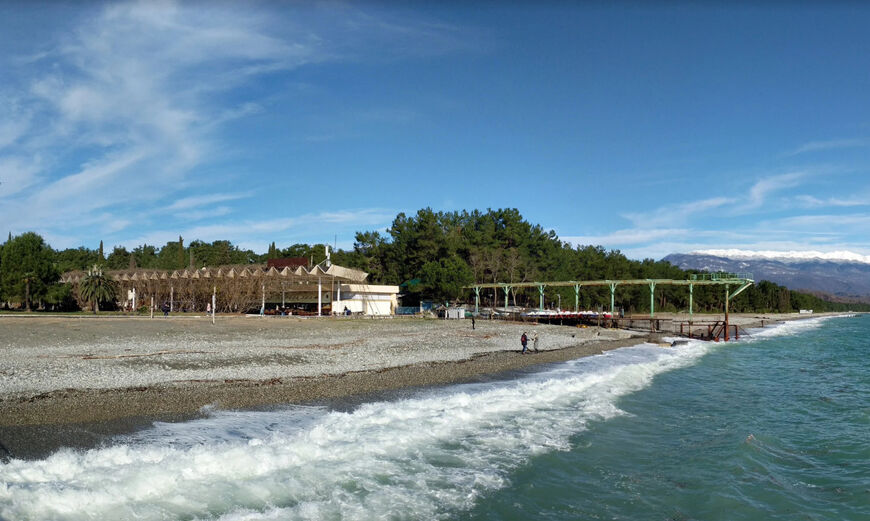
Pitsunda Beach -
The area located by the promenade and the nice pebble beach that the town has, Pitsunda Beach, can be enjoyed quite a lot despite the strong winds and large waves that bypass it.
On it there are Soviet-style sculptures, such as Sea by Irakli Ochiauri (a famous sculpture which symbolizes a swimming season), and Pitsunda Lighthouse, an iron tower that helped sailors for decades (nowadays it doesn't work anymore).
Sea by Irakli Ochiauri - Pitsunda Abkhaz Orthodox Cathedral:
10th century cathedral built by king Bagrat III of Georgia that used to
be the seat of the Georgian Orthodox Catholicate of Abkhazia until the
late 16th century (when it was conquered by the Ottoman Empire), currently used as the seat of the Abkhazian Orthodox Church (considered irregular by the Eastern Orthodox communion). The
cathedral has an impressing size and is made of three naves and three
apses, with its walls made up of alternating rows of stone and brickwork
(typical late-Byzantine technique). T
he interior of the cathedral contains vestiges of wall-painting from the 13th-16th centuries and here it was found the Manuscript of the Four Gospels (a 12th century Georgian manuscript preserved at the Georgian National Center of Manuscripts in Tbilisi). Unlike most of the Orthodox churces it has an organ (because the church was used by Catholic tourist communities in the 19th century). The church is located in a complex with other buildings called Great Pitsunda (10-19; 100₽/ 50₽ adults/ reduced). Another place to visit here is Pitsunda Town Museum, a small museum where the original frescoes and icons Pitsunda Cathedral can be seen and objects found in archaeological excavations from the ancient Greeks times..jpg/1280px-2014_Picunda%2C_Sob%C3%B3r_%C5%9Bw._Andrzeja_(07).jpg)
Pitsunda Abkhaz
Orthodox Cathedral.jpg)
Inkit Lake - On the outskirts of the town the visit can explore Pitsunda Relict Pine Reserve, a pine grove stretches along the coast for 4 km (from Pitsunda to Lidzava) with trees that are more than 200 years old. The reserve has also some lakes such as Inkit Lake.
- Very close to Pitsunda there's the village of Lidzava, a small village that has a nice beach too, Lidzava Beach. But apart from that in Lidzava the visitor can get into Khetsurian House-Museum,
small museum founded by the collector and folk artist George
Khetsuriani with original historical and ethnographic items (among them a
chaise owned by the founder of Gagra, the Prince of Oldenburg or few
large bas-reliefs).
The village is one of theSeven Shrines of Abkhazia.
Landscape of Pitsunda-Myssera
Natural Reserve - In the area between Pitsunda and Myussera the visitor can explore Pitsunda-Myssera Natural Reserve, a 38 km² reserve that connects Pitsunda Peninsula and Myssera Upland and has picturesque forests, beaches and plains where rivers flow into the Black Sea. It has the endemic pine of Pitsunda, a rare species of pine that listed in IUCN Red List of Threatened Species.
-
The area located by the promenade and the nice pebble beach that the town has, Pitsunda Beach, can be enjoyed quite a lot despite the strong winds and large waves that bypass it.
Gagra (Гагра in Abkhaz, გაგრა in Georgian, Гагра in Russian): 12,002 inhabitants seaside town in the northwestern part of Abkhazia, 80 km far from Sukhumi and 22 km far from Sochi. The town had 26,636 residents in 1989 but after the Georgian-Abkhaz conflict (1992–93), ethnic cleansing of Georgians and other circunstances its population was importantly reduced. It was a popular health resort in the times of the Russian Emprie and the Soviet Union because of its subtropical climate.
Promenade and beach in Gagra - Ruins of Abaata Fortress:
remains of the a fortress originally built in the 5th-6th centuries but
destroyed and restored several times. Most of the remnants were
destroyed in the beginning of the 20th century when the
Prince of Oldenburg ordered the construction of a hotel here. Today only some remnants of the fortress walls and towers are visible. In the complex of the fortress it can be visited the Historical Museum Abaata (10-18; 100₽/ free adults/ kids under 7), a small museum with exhibits of various historical periods of Gagra, quite focused in the Prince of Oldenburg.Gagra Church - Gagra Abkhaz Orthodox Church:
a three-nave church built in the 6th-7th centuries by the first
Caucasian Christians during Anchabadze dynasty, considered one of the
oldest buildings in Abkhazia. The church was reconstructed for Princess
Eugenia Maximilianovna of Leuchtenberg (wife of the Duke Alexander
Petrovich of Oldenburg) in 1902. It has common architectural features
with similar basilicas in eastern Georgia.
Palace of the Prince
of Oldenburg - Palace of the Prince of Oldenburg: Art-Nouveau palace designed by I. K. Luteranskiy for the Prince Peter of Oldenburg in 1902, on of the founders of the plan to create in Gagra a climatic resort (nicknamed as the Russian Nice). In Soviet times it was converted for recreation of the Soviet elite and after the Soviet collapse, the building was abandoned and looted (surviving to a fire), being bardly damaged during the Georgian-Abkhazian War. It's an architectural landmark of Gagra although now it's reduced to ruins and can't be visited.
- Marlinsky Tower: ruins of a watchtower from the 19th century, named after the Decembrist Bestuzhev-Marlinsky (who served in the garrison).
- Gagra Seaside Park: park that was built by the Prince of Oldenburg in 1902 for the decoration of the resort of
Gagra with the aim of creating a beautiful park and fill it with exotic plants. Unfortunately, during the years of Georgian-Abkhaz conflict, it fell into disrepair. It still has a water park, old rides, a tennis court, a rope park, several cafes and a mini zoo.
Independence Memorial - Independence Memorial:
monument built in memory of those killed during the armed
Georgian-Abkhazian Conflict, located in the main square in Gagra (by far
the cleanest and well kept place in town).Some of killed have their
names immortalized on the memorial.

Cave of St. Hypatius - Cave of St. Hypatius: cave where some monks lived, among them the monk and hermit Hypatius (later St. Hypatius of Gangra), who later became Bishop of Gangra (supporting St. Athanasius the Great against the Arian heresy). In his honor was erected Gagra Church. Getting to the cave isn't easy (having to climb 12 m of rock) and the place is very seldom visited by tourists.
- Near the sanatorium Solnechnyy it can be seen Stalin's Summer House, one of the dachas that he owned.
- In Gagra there's also one of the shortest rivers in the world, river Reprua, only 27 m. The sources of the river are the springs in karst Krubera Cave and it flows into the Black Sea.
Not far from Gagra, only 5 km far from the border with Russia, it's located the 5,170 inhabitants town of Tsandripsh (Цандрыҧшь in Abkhaz, განთიადი in Georgian, Цандрыпш in Russian) whose inhabitants are mostly Abkhaz Armenians. It's the most touristic and developed of the quiet resort towns in Abkhazia because of the proximity to the Russian border although it's still quite launched and dilapidated. The visitor can enjoy the nice beaches that are located here such as Tsandripsh Beach, a 8 km long pebble beach with clean water that has a part with small white cliffs. Another posibility is visiting the Ruins of Tsandripsh Church, remnant of a three-apse basilica from the 6th century basilica (considered one of the oldest Christian temples in Georgia) built by the Byzantine Emperor Justinian I for Abazg tribes when they got Christianized. It was modified several times in the 8-10th centuries and partly destroyed by Ottomans in 1576.
Tsandripsh Beach 
Ruins of Bzyb Church - In the way to Ritsa Relict National Park the visitor can explore in the village of Bzyb the Ruins of Bzyb Church (50₽/ free adults/ kids under 12).
This ruined church by river Bzyb used to be part of the Bzyb fortress,
dating back to the 9th-10th centuries. The church may have served as the
seat of the Byzantine bishop of Soterioupolis. Only the ruins of walls
covered with blocks of hewn stone survive and it's reported that is in
an inadequate state of conservation.
- Ruins of Abaata Fortress:
remains of the a fortress originally built in the 5th-6th centuries but
destroyed and restored several times. Most of the remnants were
destroyed in the beginning of the 20th century when the
Ritsa Relict National Park (also known as in Abkhaz, რიწის დაცული ტერიტორია in Georgian, Национальный парк Рица Реликт in Russian): 311 km² national park in the northern part of Abkhazia, close to the border with Russia, whose main aim is protecting Lake Ritsa and the flora and fauna in the surrounding mountainous region. The landscape of the national park consists in mountain with different heights, lakes of different sizes, glaciers, caves rivers and waterfalls. The national park has also rich fauna and flore and is usually reached from Gagra. It's recomended to visit from Apr to Oct.
Ritsa Relict National Park - Gulpripshi (Гәылрыҧшь in Abkhaz, გულრიფში in Georgian, Гульрыпш in Russian): 3,910 inhabitants seaside town that is 12 km far from Sukhumi and capital of the district with the same name.
The town had 10,697 residents in 1989 but after the Georgian-Abkhaz conflict (1992–93) it experienced a significant population decline due to ethnic cleansing of Georgians.
Ruins of Sanatorium Smetsky - The main thing to do here is exploring the Ruins of Sanatorium Smetsky, threee tanatoria built in the early 20th century by Nikolay Smetskoy for patients with pulmonary. After the Russian Revolution the sanatoria were nationalised and nowadays just the reuins remain.
In the way to Sukhumi, stopping at the town of Dranda (3,205 inhabitants), there's Dranda Abkhaz Orthodox Cathedral. This Byzantine style cathedral is said to have been first built in the year 551 by emperor Justinian I. Dranda was the seat of a bishop in the times where the Georgian Orthodox Catholicate of Abkhazia existed. Its exterior and roof have been coveredd covering stucco, hiding much of the original brick architecture, and its original frescoes were lost with time.
Dranda Abkhaz
Orthodox Church- Another place, located between Gulpripshi and Sukhumi (in the village of Tsabal) there's another of the Seven Shrines of Abkhazia, Adagua Mountain Shrine.

Kodori Gorge - In the north-eastern part of Gulripshi district there used to be Upper Abkhazia, a corner of Abkhazia that was controlled by Georgia until the Battle of the Kodori Valley (2008). Most of its inhabitants (19,918 inhabitants) were fled after the battle because they were ethnic Svans (a subgroup of the Georgian people). Here it is located Chkhalta, a village that was the administrative center of Upper Abkhazia and of the Georgian-backed government of the Autonomous Republic of Abkhazia. Not far from here it's located the nice Kodori Gorge.
- Ochamchire (Очамчыра in Abkhaz, ოჩამჩირე in Georgian, Очамчира in Russian):
5,280 inhabitants seaside town by river Ghalidzga in the southern part of Abkhazia, 53 km far from Sukhumi. The town had 18,700 residents in 1979 but after the Georgian-Abkhaz conflict (1992–93) it experienced a significant population decline due to ethnic cleansing of Georgians.
Ochamchire - The town of Ochamchire doesn't have many things to see itself but for the Ruins of the Roman Baths and the Ruins of the Medieval Walls. It has a nice beach too, Ochamchire Beach.
In the nearby village of Ilori it can be found Ilori Abkhaz Orthodox Church, a 11th century church that belonged traditionally to the Georgian church, being one of the most important sites of western Georgian architecture and one of the more significant religious locations of medieval western Georgia. The building has a single-nave design, having underwent several important architectural modifications (among other,s in the 17th century under Levan II Dadiani). In the 2010 restoration, Abkhazian authorites installed a Russian style dome and the interior was partially repainted in white (plastering the Georgian inscriptions carved).Ilori Abkhaz
Orthodox Church
A bit further it can be visited, in the 288 inhabitants village of Bedia, Bedia Abkhaz Orthodox Cathedral. This cathedral was built in the 10th century, under king Bagrat II of Abkhazia (then first king of the Georgia as Bagrat III, buried in the church), although most of the building dates back to the 13th-14th centuries. Bedia used to be the center of a diocese and the seat of a bishop until the 17th century, considered one of most significant ecclesiastical, cultural and educational centre of Georgia. It has a bell tower and fragments of murals (specially interesting one representing Bagrat II and representatives of the Dadiani noble family of Georgia) and the ruins of an old palace are here too (the dome and drum are currently collapsed).
Bedia Abkhaz
Orthodox Cathedral
Going 15 km north, in the village of Mokvi (939 inhabitants), the visitor can have a look at Mokvi Abkhaz Orthodox Cathedral, a 10th century cathedral built under king Leon III of Abkhazia that was a seat of a bishop in the Catholicate of Abkhazia until the 17th century. The church consists of five naves and is said to have been painted during the reign of Emperor Alexios I Komnenos and David IV of Georgia. The church used to have an important library with antiquities of significance and artistic value like Mokvi Four Gospels.
Mokvi Abkhaz
Orthodox Cathedral- Continuing north it can be visited Abrskil Cave (9-18; 250₽, tours only begin with enough people), a
stalactite cave near the village of Otap (named after Abrskil, the
Abkhaz Prometheus) tha is more than 2 km long (1.5-1.7 km accessible)
with a beauty that is usually compared with New Athos Cave (but far less touristic).
Ruins of St. Tommaso Fortress - In case of going northwest, towards Sukhumi, the visitor can stop at the village of Kyndyg (711 inhabitants), a village that is famous because of its hot springs, Kyndyg Hot Springs (6-22; 150₽). Here it can also be seen the Ruins of St. Tommaso Fortress, remains of a fortress that was built in the Genoese period (from the 13th to the 15th century) till it was surrendered to the Turks in the second half of the 15th century.
- The town of Ochamchire doesn't have many things to see itself but for the Ruins of the Roman Baths and the Ruins of the Medieval Walls. It has a nice beach too, Ochamchire Beach.
- Tkvarcheli (Тҟəарчал in Abkhaz, ტყვარჩელი in Georgian, Ткварчели in Russian):
5,013 inhabitants town on the river Ghalidzga that is 30 km far from Ochamchire, very linked to coal mining. The town had 21,744 residents in 1979 but after the Georgian-Abkhaz conflict (1992–93), in which the unsuccessful Siege of Tkvarcheli was put by the Georgian Army, most of its population escaped from here (after the war all the industries closed too).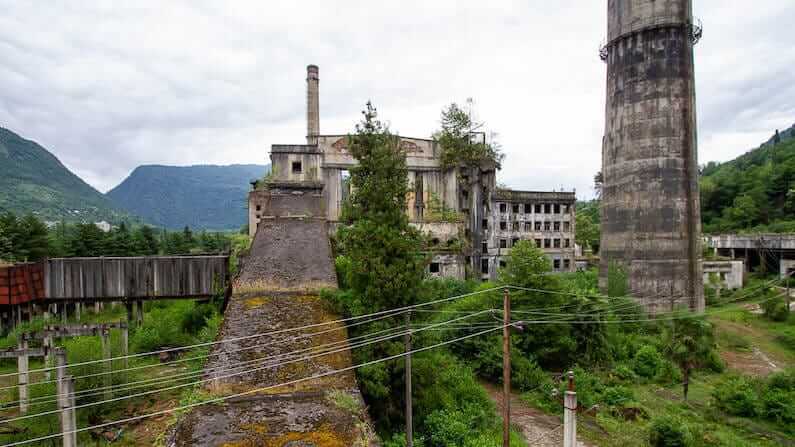
Thermal Power Plant of Tkvarcheli - The
town has many of its industrial buildings abandoned that are preserved
in ruins or about to collapse. One of the most picturesque ones is the Thermal Power Plant of Tkvarcheli.

Abandoned buildings in Akarmara - Only 8 km far the visitor can explore a mysterious town with abandoned apartments and factories which became uninhabited due to the War in Abkhazia in the early 1990s, the Ghost Town of Akarmara.
- On the outskirts of Tkvarcheli the visitor can reach Lashkendar, a 1,373 m high mountainconsidered one of the seven shrines of the Abkhaz people. There are also ruins of a Christian temple featuring bas-reliefs of leopards (or possibly dogs) from the 7th-11th centuries.
Close to the villiage it can be found Gupsky Waterfall and Canyon, a narrow gorge on the river Sue with a waterfall. At the base of the waterfall there's a kind of pool where the visitor can swim and below the surfece, on the banks of the river, there is some blue clay (used for cosmetic purposes).Gupsky Waterfall
- The
town has many of its industrial buildings abandoned that are preserved
in ruins or about to collapse. One of the most picturesque ones is the Thermal Power Plant of Tkvarcheli.
- Close to the border with Georgia it's located Gali (Гал in Abkhaz, გალი in Georgian, Гал in Russian), a town with 7,605 inhabitants located 77 km southeast to Sukhumi.
According to the Soviet census of 1989 it had 15,763 inhabitants by
then, most of them Georgians (concretely Mingrelians). Nowaday the
majority of the population is still ethnic Georgian despite having been
one of the most affected areas affected by the war.
What and where can I eat in North Ossetia-Alania?
 |
| Typical Ossetian meal |
 |
| Fydjyn pie |
These are some basic words in Ossetian:
Ossetian
|
English
|
Ossetian
|
English
|
Арфæ
/Arfeh/ |
Hello
|
Бузныг
/Booznig/ |
Thank you
|
Куыд цæрут?
/Koobihd tsehroot?/ |
How are you?
|
Бахатыр кæнут /Bakhatihr kehnoot/
|
Excuse me
|
Фенынмæ!
/Feninmeh!/ |
Goodbye!
|
О
/Oh/
|
Yes
|
Дæ уæ райсом хорз! /Deh ooeh eezhr horz!/ |
Good morning!
|
Нæ
/Neh/ |
No
|
Аҵх алҧха уоуааит!
/Ac̄x alṗxa uouaait!/ |
Good night! |
Сымах уырыссагау англисагау? /Simakh ooihrihshagau anglishagau?/
|
Do you speak English? |
Useful links
In case you want to look for more information about Abkhazia (https://visitabkhazia.ru/ [RU]; other page about tourism in Abkhazia: https://abkhazworld.com/aw/abkhazia [EN]) or its cities and towns, here there's a list with some pages to get it:- Novy Afon (http://afon-abkhazia.ru/) [RU].
- Vladikavkaz (http://www.vladikavkaz-osetia.ru/) [RU].



 09:07
09:07
 Banknotemaniac
Banknotemaniac

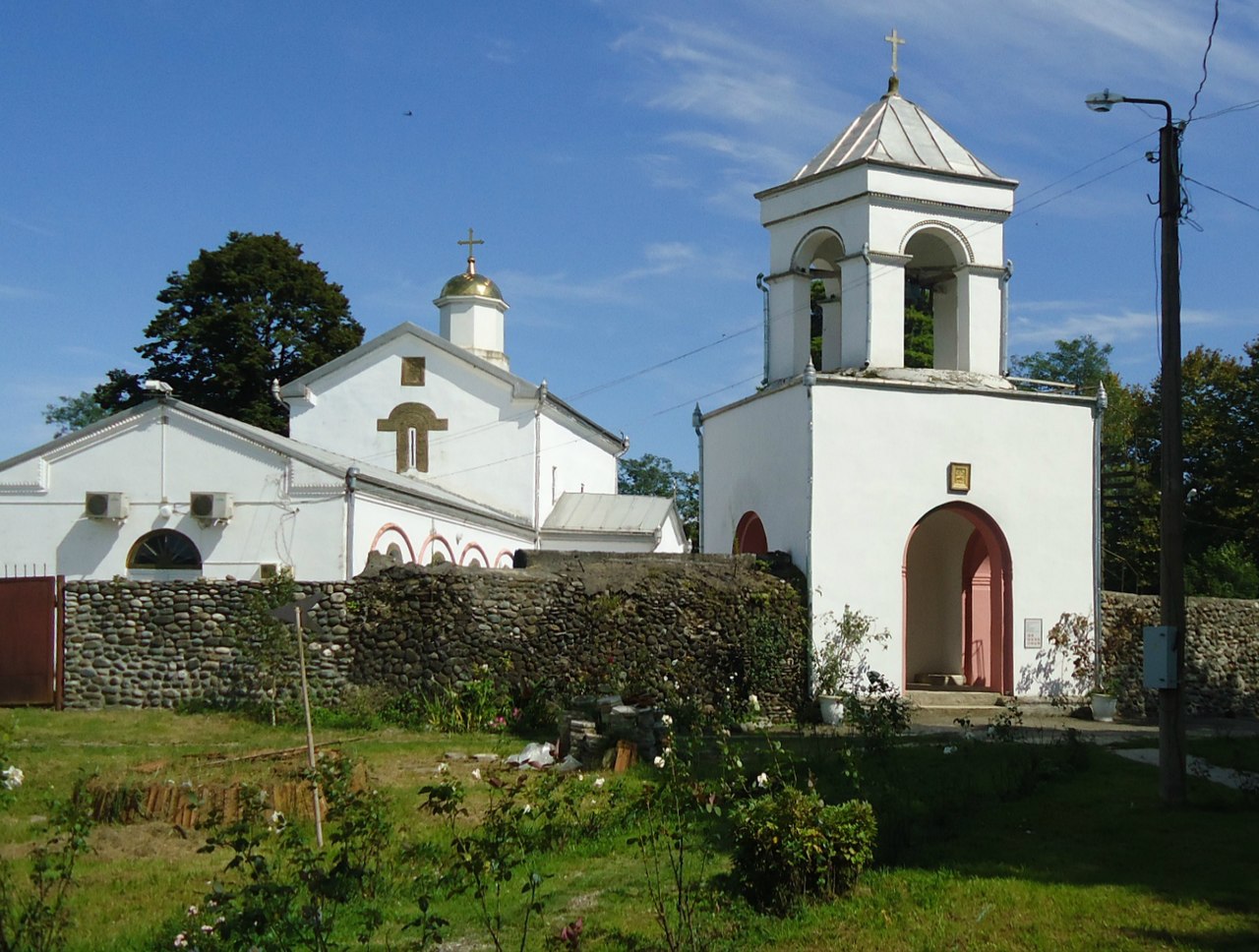
 Posted in:
Posted in: